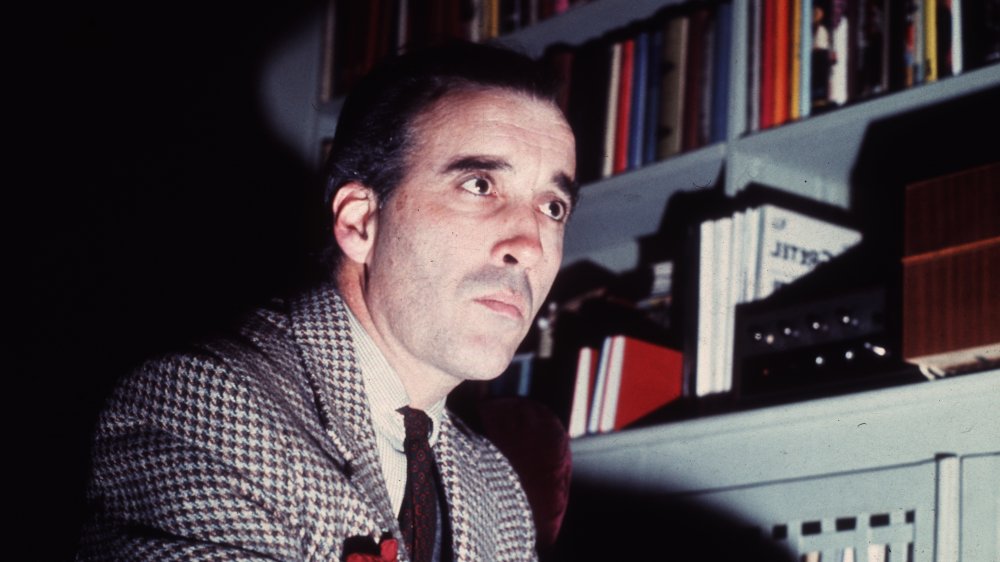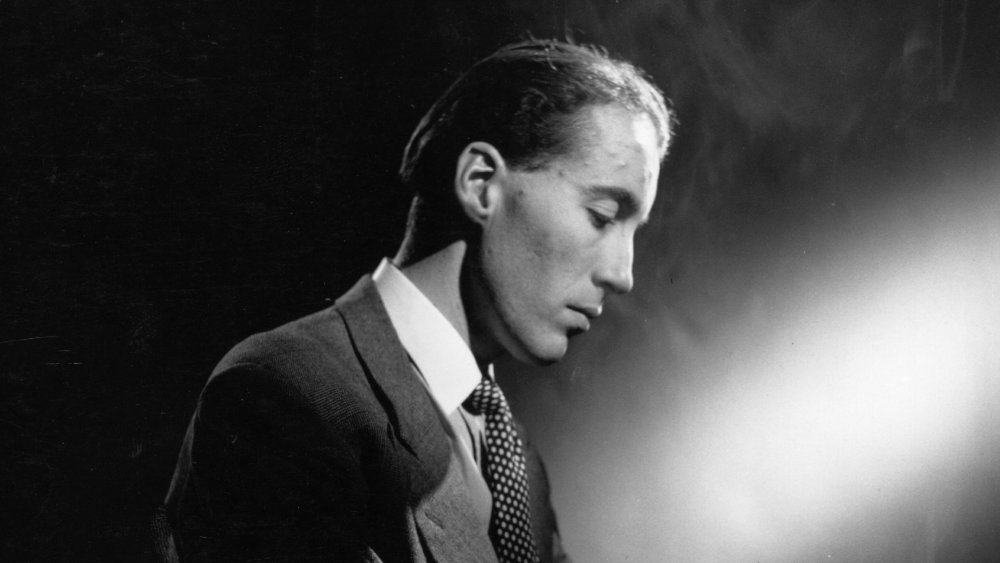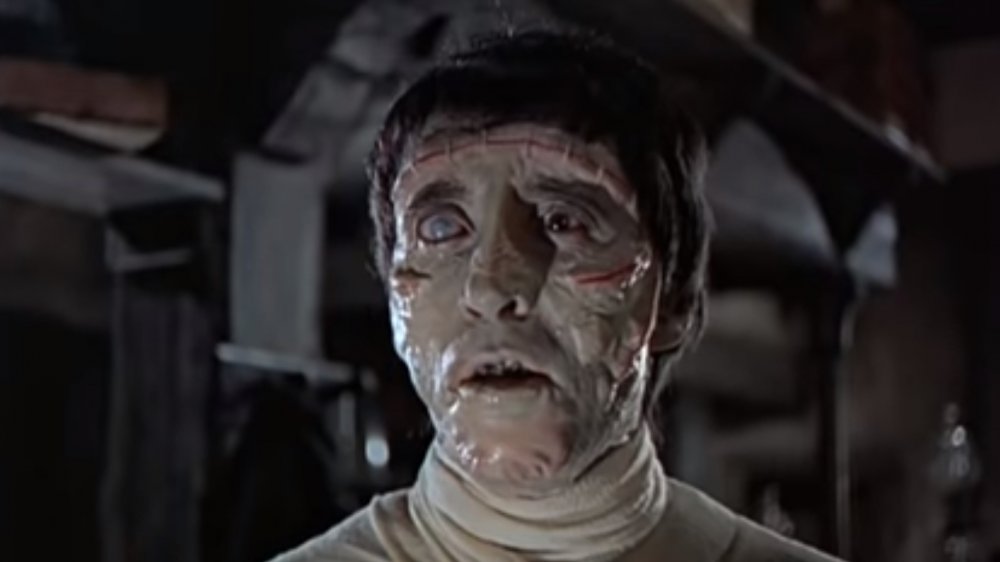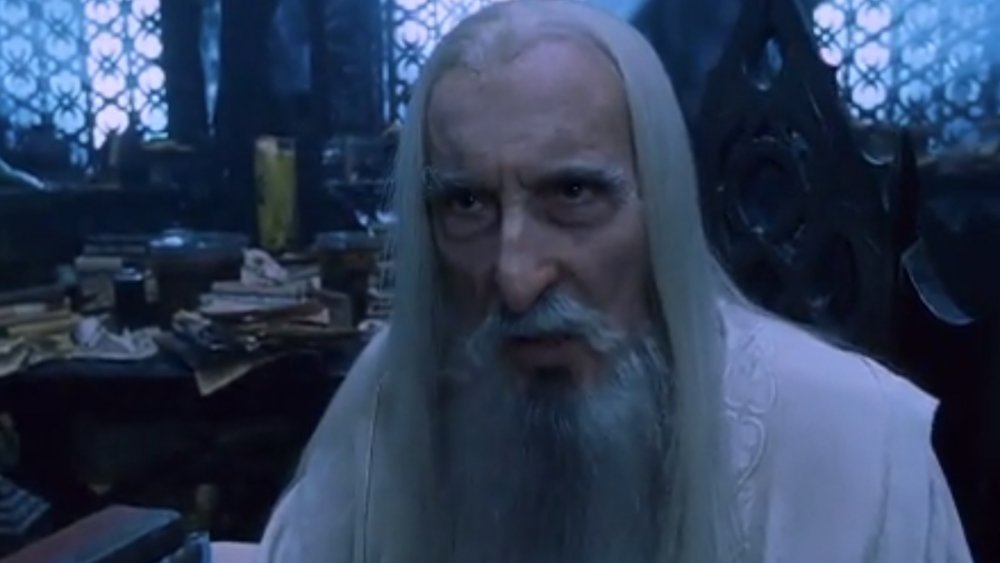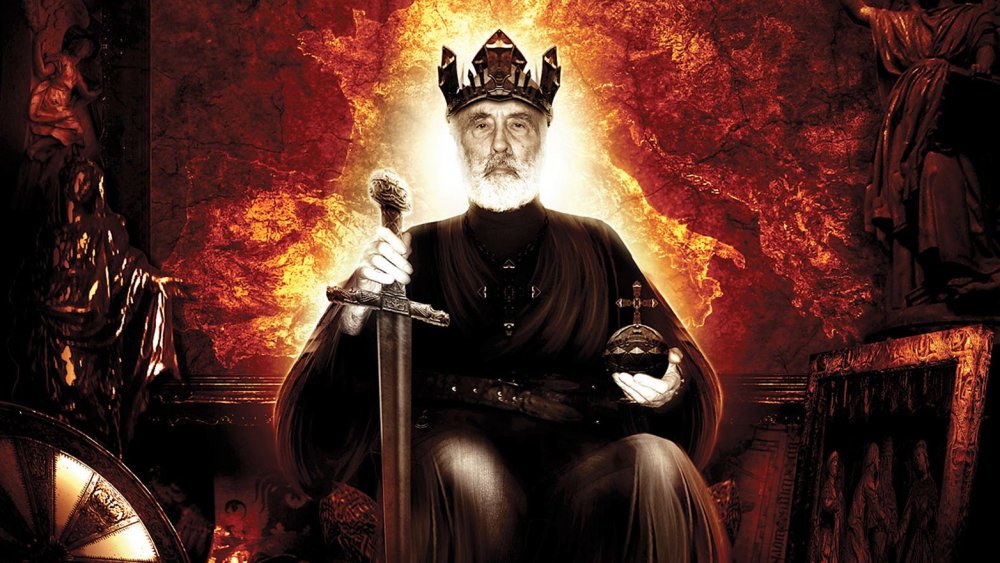The Amazing Story Of Horror Icon Christopher Lee
With cinematic appearances spanning seven decades, Sir Christopher Lee had the kind of career that most actors dream of. Whether you remember him as the man with the golden gun, Count Dooku, or Saruman the White, odds are that Lee appeared in one of your favorite films.
With his dark good looks, imposing 6'5" frame, and commanding voice, Lee was born to play dashing villains. From 1958 to 1973, he appeared in his career-defining role as the vampire Count Dracula in a series of wildly popular horror films for Hammer Studios. Although Dracula made him a superstar, Lee came to regard the role with ambivalence, viewing his long association with the role as limiting.
Despite being typecast as a horror actor and facing a lack of quality roles during the middle portion of his career, Lee worked consistently in film and television through the lean times to experience an unprecedented revival in his golden years.
However, his life was much more than the sum of the dastardly parts for which he was known. The definition of the modern Renaissance man, Christopher Lee's life offscreen was more compelling than any movie. From his illustrious military service during World War II to his second career as a nonagenarian heavy metal singer, Lee filled his 93 years with adventure, mystery, and meaning. This is his amazing story.
Christopher Lee's privileged youth
Born in London's Belgravia district on May 27, 1922, Christopher Frank Carandini Lee came by his aristocratic bearing honestly. His father, Lieutenant Colonel Geoffrey Trollope Lee, a burly sportsman, was an officer in the British Army who had served with distinction in the Boer War. Lee's mother, Estelle Carandini di Sarzano Lee, was an Italian contessa whose royal lineage stretched back to Charlemagne. The Lees' second child, preceded five years earlier by sister Xandra, baby Christopher's arrival was considered a not-so-welcome surprise to his parents. As Lee jokingly writes in his 1977 autobiography, Tall, Dark, and Gruesome, "I was 'a mistake.' My mother often told me so. In her late 80s, she was still firm in her original opinion."
Just after his fourth birthday, Lee's father suddenly left his mother after 16 years of marriage. The couple would divorce two years later. The Contessa, with children in tow, moved to the Swiss village of Wengen where young Christopher was enrolled in Miss Fisher's Academy in nearby Territet. A rambunctious child, six-year-old Lee was initially no fan of the school. "I expressed my opinion of the place by running away, once a week," Lee writes, "I was always tracked down. . . and severely punished. This had no effect whatever, and I repeated the performance with great regularity." Nevertheless, Lee credited Miss Fisher's with introducing him to the stage and his first villainous role as Rumpelstiltskin in a school play.
Christopher Lee's scholarly pursuits
As abruptly as the Lees had left for Switzerland, they returned to London where Christopher Lee enrolled in Wagner's, a prestigious private school in Queen's Gate. Young Christopher had a penchant for causing trouble that often landed him in hot water with authority. Claiming that he needed only to "breathe nervously" to be flogged, Lee wrote of his time at Wager's that the headmaster "beat me as often as he needed exercise."
Following his mother's marriage to second husband banker Harcourt George St-Croix Rose, nicknamed Ingle, the family moved to a townhouse in Fulham and nine-year-old Christopher Lee was sent to Summer Fields School in Oxford in preparation to attend prestigious Eton College. Excelling in most of his subjects, Lee applied for and won a scholarship to the celebrated school. Taking his oral examination in the presence of master ghost story author M.R. James, Eton's Provost, whom Lee would play in the BBC's Ghost Stories for Christmas in 2000, Lee won an Oppidan scholarship, an award with a smaller stipend than the King's scholarship he had been aiming for.
Unfortunately, Lee's stepfather's fortunes had diminished and he was unable to meet the financial shortfall the lesser scholarship entailed. He would instead attend Wellington described by Lee as a military academy with a "Classics side." Lee was a good student earning scholarships for his marks in classical literature and language. However, Lee's scholarly pursuits would end a year before his scheduled graduation when his stepfather's bankruptcy forced him to leave school.
Christopher Lee's military career
During the Winter War of 1939, Christopher Lee volunteered for the Finnish Army in their efforts against the Soviet Union. However, the small British contingent was soon sent home without seeing action. With the possibility of being conscripted looming at the outset of World War II, Lee enlisted in the Royal Air Force. Sent for flight training in South Africa, Christopher Lee's dreams of aerial combat were dashed due to a defect in the optic nerve of his left eye that rendered him unable to fly.
Lee instead volunteered for RAF Intelligence. As an intelligence officer, his duties included breaking German codes, providing support to ground troops, and coordinating air operations on the African front. Toward the end of the war, Lee was stationed with the Indian Gurkhas as part of an officer exchange program with the British Army seeing action at the Battle of Monte Cassino, per Forces. In the final days of his military career, Lee claimed to have helped track down and interrogate Nazi fugitives as part of the Central Registry of War Criminals and Security Suspects.
Throughout his life, Lee remained tight-lipped about much of his wartime service, occasionally dropping tantalizing hints about espionage and secret missions with the Special Air Service leading some historians to chalk up portions of his record to hyperbole. What can be definitely discerned from the available facts is that Lee served with honor and was a war hero by anyone's measure.
Lee becomes an actor
With his military service complete, Christopher Lee had little interest in returning to a job. With dwindling funds, Lee accepted an invitation to lunch from his cousin, Nicolò Carandini, a former Italian resistance leader and Italy's first envoy to the Court of St. James since Mussolini's fall. As the two swapped stories, Carandini asked, "Why don't you become an actor, Christopher?" This simple query was a revelation to the directionless young man. In his 1977 autobiography, Lee remembered the fateful lunch writing, "Between the Chianti and the persuasive tones of a man whose very nature was designed to make the solutions to complex problems merely a matter of will power, I exclaimed, 'What a wonderful idea! I'd love to be!'"
With Carandini's help, Lee secured a meeting with the head of the Rank Organization's Two Cities Films who decided the budding 25-year-old would-be actor was just what the movies needed and sent him to producer Josef Somlo. Unimpressed, Somlo declared Lee "too tall" to be an actor. Nevertheless, the Rank Organization gave Lee a modest seven-year contract.
Yet, that contract didn't guarantee work, and Rank's directors rarely hired Lee because of his height and "foreign" looks. Relegated to bit parts including a background role in Laurence Olivier's Hamlet, Lee studied his more seasoned peers learning his craft on the job. For a decade, Lee struggled in supporting roles in a film career he described as "a sado-masochistic switchback."
Christopher Lee and Hammer Horror
Founded in 1934, Hammer Film Productions was one of Great Britain's oldest movie studios. Prior to World War II, the company turned out films across a variety of genres ranging from comedies and mysteries to melodramas. With the war came a turn in the studio's fortunes as the British film industry ground to a halt.
After the war, Hammer returned as a "B" movie programmer producing quick, cheap filler movies to support more expensive features. In 1955, the studio scored its first unqualified genre hit with the sci-fi horror film Quatermass Xperiment. However, the studio's turn to gothic horror would change everything for both Hammer and 35-year-old Christopher Lee.
By 1957, Christopher Lee had more or less resigned himself to a career as a supporting actor, and his next role seemed even less likely to propel him to stardom. Cast as the monster in Hammer Films' rehash of Frankenstein, the mute, makeup-heavy part was to Lee one more indignity to be suffered to put food on the table.
Pairing Lee with Peter Cushing as mad scientist Victor Frankenstein in a stylish and bloody update of Mary Shelley's classic tale, The Curse of Frankenstein was a worldwide box-office smash. With the winning combination of Lee, Cushing, and director Terence Fisher, the age of Hammer Horror had arrived.
Lee was born to play Dracula
Although Bela Lugosi's iconic turn as the vampire count in Universal Pictures 1931 classic remains the most recognized cinematic portrayal of Dracula, no actor played the part on screen more than Christopher Lee. His record ten outings as the aristocratic, Transylvanian bloodsucker began with 1958's Horror of Dracula. The film pitted Lee against his The Curse of Frankenstein co-star Peter Cushing as vampire hunter Doctor Van Helsing.
In the nearly three decades since Lugosi's indelible film performance, the public conception of Dracula had lapsed into parody. As author David J. Skal explains in his 1993 cultural history of the horror genre, The Monster Show, Lenny Bruce and other comedians had done much to dull the venerable vampire's bite creating a standard impression of the character that was "vocally closer to Jackie Mason than to Bela Lugosi."
Lee's interpretation of the character, however, shattered any overtures to satire. The Dracula of the Hammer films is a brooding, yet commanding presence charged with a simmering sexuality that prior versions had only hinted at.
Studiously avoiding the 1931 film, Lee based his performance entirely on Bram Stoker's book which he read twice before the production commenced. Of the character, Lee writes, " . . . there were aspects of him with which I could readily identify — his extraordinary stillness, punctuated by bouts of manic energy . . . his power complex; the quality of being done for but undead; and by no means least the fact that he was an embarrassing member of a great and noble family."
The Wicker Man
Throughout the 1960s, Hammer's Dracula series remained Lee's most popular (and profitable) work. Despite his declining interest in the role as well as the diminishing quality of the films, he continued to play the part, at times under duress. In 1973, Hammer's long-in-the-tooth vampire was finally laid to rest in The Satanic Rites of Dracula much to Lee's relief.
However, Christopher Lee's life as a horror superstar was far from over. The Wicker Man, directed by Robin Hardy from a script by Anthony Shaffer, would find Lee in an all-new kind of horror movie. A cerebral film rooted in folklore and ritual magic, The Wicker Man features Lee as Lord Summerisle, the charismatic leader of a pagan enclave located on an isolated island in the Outer Hebrides. When devout police sergeant Neil Cowie (Edward Woodward) is summoned to the reclusive community to find a missing child, he slowly discovers that his mission is not what it seems.
In Summerisle, Lee at last found a role with a complexity worthy of his aspirations. Although The Wicker Man was only a moderate success and suffered from studio-imposed edits that damaged its complex narrative, it has since become a cult favorite for its uniquely literate take on the genre. Cinefantastique declared the film "the Citizen Kane of horror movies." Of his many films, Lee cited The Wicker Man man as his favorite, stating the film was the "best scripted film I ever took part in."
Lee as a Bond villain
Had author Ian Fleming had his way, Christopher Lee would have appeared in the first James Bond film. As Lee relates in his 1977 autobiography, Fleming, a nephew of Lee's stepfather, suggested the actor would be perfect as the villain in the upcoming film adaptation of his 1958 novel Dr. No. Naturally, Lee was enthusiastic about the possibility of portraying the metal-handed madman. Unfortunately for Lee, actor Joseph Wiseman had already been cast when Fleming made his suggestion to producers Albert Broccoli and Harry Saltzman.
In 1974, Lee finally got his chance to take on 007 in the ninth Bond film, The Man with the Golden Gun. In the film, Lee is pitted against Roger Moore's James Bond as millionaire assassin-for-hire, Francisco Scaramanga. Scaramanga, a former circus trick shot artist recruited by the KGB, is notorious for his use of an ingenious golden gun assembled from the seemingly innocuous components of a pen, cigarette case, lighter, and cufflinks.
A highlight of an otherwise unremarkable entry in the Bond franchise, Lee's performance was the focus of the scant critical praise The Man with the Golden Gun received. Departing from Fleming's vision of the character in the original novel, the brutish Scaramanga is transformed into a dark and dashing figure who functions as a thematic flipside to Bond. Yet, as perfect as Lee is as Scaramanga, the role was originally supposed to have gone to character actor Jack Palance.
Christopher Lee's late career Renaissance
It's a bit inaccurate to characterize Christoper Lee's late-career revival as a "comeback." Although his popularity may have waned in the late 1970s and '80s, he worked consistently in both film and television. Lee showed a rare comedic side appearing as Nazi Naval Officer Wolfgang von Kleinschmidt in Steven Spielberg's doomed 1979 World War II farce 1941. Throughout the '80s, he would occasionally return to the horror genre. In 1983, he teamed up with fellow horror legends Peter Cushing, Vincent Price, and John Carradine for the stylish thriller House of Long Shadows. Yet, the '80s also saw Lee in a few cinematic misfires such as 1985's The Howling III: Your Sister is a Werewolf.
The following decade, however, would find Lee at the height of his powers as an actor. In 1998, he took on the role of Muhammad Ali Jinnah, founder of Pakistan, in the film Jinnah. Although the film would see a limited release, much to Lee's disappointment, he considered his performance the best and most important of his career.
Filmmaker Tim Burton, a longtime fan of Lee's work, cast the veteran actor in a cameo role as a stern burgomaster, in his homage to Hammer-styled horror, in 1999's Sleepy Hollow. The small role would lead to a long working relationship and friendship with Burton who went on to cast Lee in Charlie and the Chocolate Factory, The Corpse Bride, Alice in Wonderland, and Dark Shadows.
Lee in Star Wars and The Lord of the Rings
In 2001, director Peter Jackson cast Lee as turncoat wizard Saruman the White in his long-awaited, big-budget film adaptation of J.R.R. Tolkien's Lord of the Rings: The Fellowship of the Ring. Lee had long desired to appear in a film version of Tolkien's books, however, he originally had his sights set on another, more heroic character. With his knowledge of folklore and the occult, Lee assumed he was a shoo-in for the benevolent sorcerer Gandalf. Peter Jackson, however, had other plans for Lee. After allowing Lee to audition for the coveted role, Jackson called Lee back to inform him that he had cast Ian McKellen as Gandalf but wanted him for the villainous Saruman.
Just one year later, Lee appeared as evil Sith Lord Count Dooku in the second Star Wars prequel Attack of the Clones. With prominent roles in two of the most popular film franchises in cinematic history, Lee, then in his 80s, found himself in the enviable position of being Hollywood's most bankable star. Upon his 2009 knighthood, Lee reflected on his legacy. As reported by The Sydney Morning Herald, Lee stated, " A whole new career opened up for me when I was in Lord of The Rings and Star Wars (Episode II: Attack of the Clones) ... What's really important for me is, as an old man, I'm known by my own generation and the next generation knows me too."
Lee was an unlikely metal god
At an age when most people are enjoying the calm serenity of retirement, Sir Christopher Lee embarked on a second career in the most surprising field. A talented singer, with a deep baritone voice, Lee recorded his first full album of symphonic heavy metal at the age of 88. With lyrics worthy of Iron Maiden, Charlemagne: By the Sword and the Cross, garnered Lee Metal Hammer's "Spirit of Metal Award."
A longtime fan of heavy metal and hard rock, Lee developed an interest in the extreme musical genre in the early '70s when he heard Black Sabbath. Conversely, Black Sabbath guitarist Tony Iommi told Lee in a 2014 Metal Hammer interview he conducted with the actor that Lee's work in horror films had inspired the direction of the band.
In 2013, just in time for his 91st birthday, Christopher Lee released his final metal album, Charlemagne: The Omens of Death.
The iconic Lee says farewell
On June 7, 2015, Sir Christopher Lee died at the age of 93. Having been admitted to London's Chelsea and Westminster Hospital, the beloved actor succumbed to heart failure and respiratory difficulties. Upon the announcement of Lee's passing on June 11, numerous tributes to the screen legend poured in from friends and peers including British Prime Minister David Cameron, George Lucas, Roger Moore, Mark Gatiss, and Johnny Depp.
In a touching memorial published in Entertainment Weekly, friend and director Tim Burton warmly said of Lee: "He experienced everything, and remained positive and interested and creative all the way through." Filmmaker Peter Jackson memorialized the late actor on his Facebook page, writing, "There will never be another Christopher Lee. He has a unique place in the history of cinema and in the hearts of millions of fans around the world ... The world will be a lesser place without him in it."


